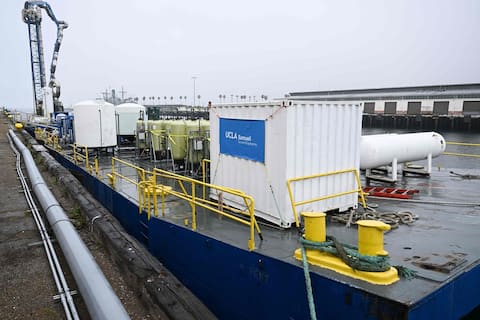
In Los Angeles Harbor, a strange boat covered in pipes and tanks is home to an idea that promises to make waves: to use the ocean as a CO2 sponge, removing this greenhouse gas from the ocean. ‘Atmosphere.
• Read more: Climate skepticism is making its way into scientific journals
A team of UCLA scientists has been working for two years on this ambitious project to combat global warming called SeaChange.
“Their goal is to use the ocean like a giant sponge,” Gaurav Sant, director of UCLA’s Institute for Carbon Management (ICM), told AFP.
The oceans that cover most of the Earth are our best climate ally because the ocean acts as an essential buffer: it absorbs more than a quarter of all carbon dioxide (CO2) emissions and 90% of the heat they have released in recent decades.
But the planet’s main carbon sink is at risk: the ocean is acidifying and rising temperatures are reducing its absorption capacity. The team wants to increase that, thanks to an electrochemical process that removes CO2 from seawater.
“If we can remove carbon dioxide from the oceans, we are renewing our ability to capture additional carbon dioxide from the atmosphere,” said Mr. Sant sums it up. Like squeezing a sponge to restore its absorbent power.
Trapped in minerals
So the engineers built a floating mini-factory on a barge about thirty meters long, which pumps seawater and subjects it to electricity.
Electrolysis triggers a series of chemical reactions that initially neutralize the CO2 in the water. It is encased in a fine white powder containing calcium carbonate, an element found in lime, chalk or shells, and magnesium bicarbonate.
According to Mr Sant, these natural minerals can be released into the ocean, which “stores CO2 in a very sustainable way (…) for tens of thousands of years”. And the pumped water returns to the ocean, ready to reabsorb greenhouse gases from the air.
The engineer is convinced that the process will have no impact on the marine environment, an intuition that needs to be confirmed.
In addition to removing CO2 from the atmosphere, the process produces hydrogen, a gas essential for the energy conversion that will power tomorrow’s clean trucks, trains or airplanes.
A priority for preventing climate change is drastically reducing our C02 emissions, which humanity is currently unable to do.
But at the same time, most scientists point out that CO2 capture and storage techniques, collectively termed “carbon dioxide removal” (CDR), can play a complementary role in keeping the planet livable.
The first is to achieve carbon neutrality by 2050 by offsetting emissions from industries that are more difficult to decarbonise, such as aviation, cement or steel. Then, hit the stocks of CO2 that have accumulated in the atmosphere over decades.
• Read more: The G7 final sprint to improve its action to address the climate emergency
“Promising Solution”
Between 450 billion and 1.1 trillion tons of C02 must be removed from the atmosphere by 2100 to keep warming in check, according to the first global report released in January.
It predicts the CDR sector will “grow at a rate of 30% per year over the next 30 years, with solar and wind growing,” asserts one of its authors, Gregory Nemet, a professor at the University of Wisconsin. – Madison.
UCLA’s technology “falls into the category of promising solutions that are large enough to have an impact on the climate,” he said.
By sequestering CO2 directly into the ocean in inorganic form, it clearly distinguishes itself from another popular technique: direct capture of CO2 from the air (DAC). This requires finding a site to store the gas on land, a very complex and expensive process.
“A big advantage of our process is that we don’t need to inject CO2 into the ground,” says Mr. Sand continues.
The project is now to be marketed by a start-up, Equatic, which is responsible for demonstrating its feasibility on an industrial scale and selling carbon credits to companies looking to offset their emissions.
Apart from the Los Angeles boat, a similar boat is currently being tested in Singapore.
Mr. According to Chant, the feedback of the two platforms makes it possible to design very large factories capable of “sequestering thousands of tons of CO2 per year.” The engineer believes they will be operational within “18 to 24 months”.







More Stories
More than 200 former Republican aides back Kamala Harris | US Election 2024
An investigation into the ill-treatment of the Lev Tahor sect in Guatemala
Brossard is suspected by the US of supporting Russia’s war effort